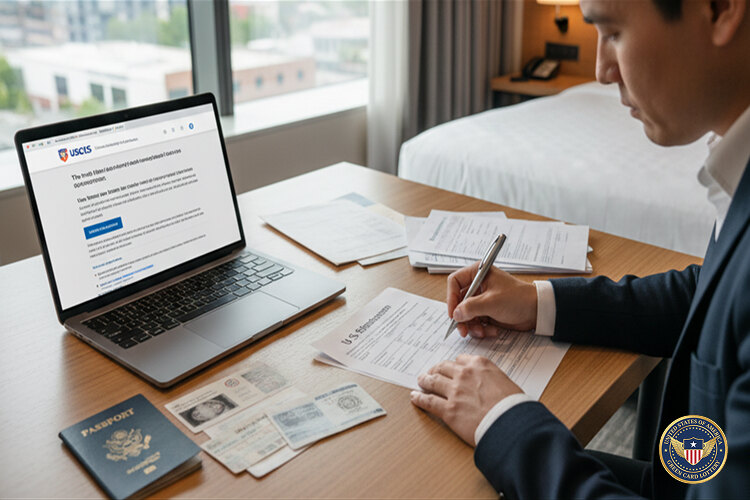
Introduction
The B-1 B-2 Visa allows millions of travelers to visit the U.S. for tourism, business, or medical treatment. But what if your meetings take longer, your treatment continues, or you need more time with family?
That’s where a B-1 B-2 Visa extension comes in. Extending your stay in the U.S. legally can help you avoid overstaying, maintain your good immigration record, and ensure smooth future entries.
In this detailed guide, we’ll explain who can apply for a B-1 B-2 Visa extension, how to file your request, what documents are required, how long it takes, and common mistakes to avoid.
If your long-term goal is to live permanently in the U.S., the US Green Card Office also helps applicants enter the Green Card Lottery (Diversity Visa Program), a legal and secure path toward permanent residency.
Table of Contents
1. When Should You Apply for a B-1 B-2 Visa Extension?
You must apply before your current authorized stay expires, as shown on your I-94 Arrival/Departure Record (not on your visa stamp).
It’s best to apply at least 45 days before your I-94 expiration date. Filing on time is crucial because late submissions can be denied, and overstaying can lead to future visa refusals or even bans.
Once you apply, you can remain in the U.S. legally while your application is pending, even if your I-94 expires.

2. How to Apply for a B-1 B-2 Visa Extension
To request an extension, you must file Form I-539, “Application to Extend/Change Nonimmigrant Status,” with the U.S. Citizenship and Immigration Services (USCIS).
Steps to Apply:
- Complete Form I-539 online on the USCIS website.
- Attach supporting documents, such as:
- A copy of your passport and visa.
- Your most recent I-94 record.
- A detailed letter explaining the reason for your extension (business, tourism, or medical).
- Proof of financial stability (bank statements, sponsor letter, etc.).
- Evidence of strong ties to your home country (property, job, family).
- Pay the filing fee (currently around $370, plus the biometrics fee).
- Submit your application electronically or by mail.
- Wait for a receipt notice (Form I-797) confirming your application has been received.
Once USCIS processes your application, you’ll receive a decision by mail.
3. How Long Can You Extend Your Stay?

A B-1 B-2 Visa extension typically grants an additional 6 months of stay in the U.S.
However, the total duration of your visit (initial + extended stay) usually cannot exceed one year unless you demonstrate compelling reasons such as medical emergencies or unforeseen delays.
4. Reasons USCIS May Deny an Extension
Common reasons for denial include:
- Filing after your I-94 expiration date.
- Insufficient financial proof to support your stay.
- Weak justification for the extension.
- Past visa violations or overstays.
- Incomplete documentation.
Pro Tip: Prepare a clear, professional explanation letter and attach solid proof of your purpose. If you’re unsure how to prepare your case, seek expert advice.
5. Can You Work or Study During an Extension?
No. A B-1 B-2 Visa does not permit employment or academic study in the U.S.
You can only stay for the purpose you initially declared, business meetings, conferences, family visits, or tourism. If you wish to study or work, you must apply for a change of visa status (for example, from F-1 to F-1 for study or from H-1 B to H-1B for work).
6. What Happens After Filing the Extension?
After submission, USCIS will:
- Send you a receipt notice (Form I-797C).
- Request additional evidence (RFE) if more details are needed.
- Issue a final approval or denial notice.
If approved, your new I-94 form will show your updated departure date. If denied, you must leave the U.S. immediately to avoid unlawful presence.
7. What If You Applied Late?
If you file after your I-94 has expired, you must include a written explanation showing that:
- The delay was beyond your control, and
- You filed as soon as reasonably possible.
Even then, approval is not guaranteed. Always file early to avoid complications.

8. What If You Plan to Stay Longer or Immigrate Permanently?
If you find yourself visiting the U.S. frequently or plan to stay long-term, repeatedly extending your B-1 B-2 Visa is not a sustainable strategy.
Instead, consider applying for a U.S. Green Card through the Diversity Visa (DV) Lottery Program.
The US Green Card Office helps applicants from eligible countries submit error-free applications year-round, even outside the official lottery registration period. Their team ensures your photo, documents, and eligibility criteria meet all official standards, improving your chances of success.
Conclusion
Extending your B-1 B-2 Visa stay in the U.S. can give you the flexibility to complete your travel, business, or medical plans as long as you follow the proper process and timelines.
Always apply early, maintain accurate records, and never overstay. For visitors who dream of calling America home, programs like the Diversity Visa (Green Card) Lottery offer a genuine path toward permanent residency.
Professional organizations such as the US Green Card Office simplify the process by handling your application accurately and in compliance, giving you peace of mind that your U.S. immigration journey is off to the right start.


